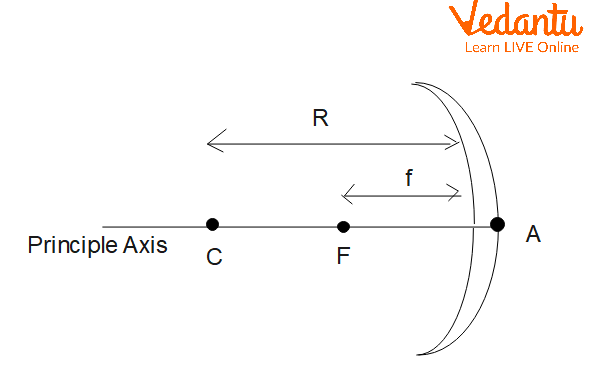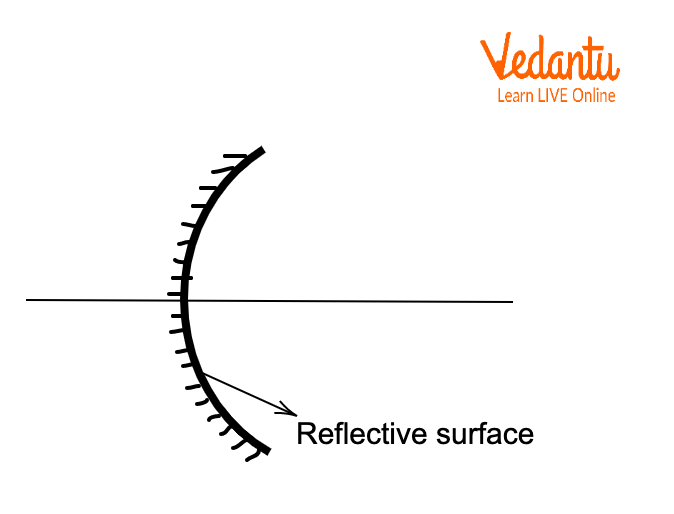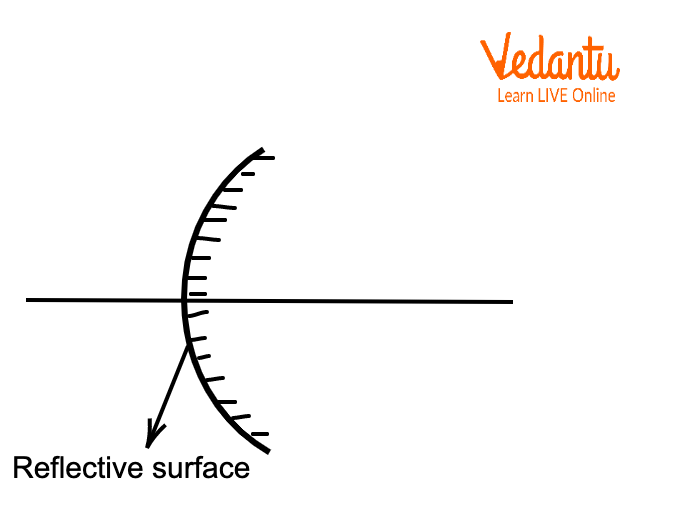




What is a Spherical Mirror?
It's conceivable that human beings exploited watery bodies of water as the first mirrors. Polished stone objects were the first constructed mirrors that are known to exist. Chinese people started using amalgams of silver and mercury to make mirrors around 500 AD. Claudius Ptolemy used curved polished iron mirrors in a number of studies. A spherical mirror is a mirror that resembles a portion of a spherical surface that has been carved out. Convex and concave mirrors are two different varieties of spherical mirrors.
Terminologies Used
Centre of Curvature: The mirror's centre point which has the same tangent and curvature at that point and goes through the mirror's curve.
Radius of Curvature: It’s the linear distance between the pole and the centre of curvature.
Principal Axis: A hypothetical line drawn through a lens or a spherical mirror's optical centre and curvature centre.
Pole: Spherical mirror's centre point.
Aperture: The real location of light reflection is at the aperture of a mirror or lens. It also specifies the mirror's size.
Principal Focus: Focal Point is another name for Principal Focus. The axis of a mirror or lens is where, following reflection or refraction, light rays parallel to the axis converge or appear to converge.
Focus: After being reflected by the mirror, light rays parallel to the primary axis will converge at any given position.
Structure of the Spherical Mirror
The larger virtual sphere is always present in a spherical mirror. Imagine a line going through the sphere's centre and coming in contact with the reflective surface. The primary axis is the name of this line.
The major axis' intersection with the reflective surface is indicated in the illustration by a point. The vertex, which is located in the mirror's centre, is Point A.
Point C in the illustration designates the location of the sphere's centre, from which the spherical mirror has been sliced. The curve's centre is located here. The radius of curvature, represented in the illustration by the length 'R,' is the distance from the vertex to the centre of curvature.
The focal point, denoted as "F" in the diagram, is the point that is situated halfway between the vertex and the centre of curvature. The focal length of the mirror is the distance denoted by 'f' in the diagram. It is the separation between the mirror's vertex and focal point.

Spherical Mirror
Types of Spherical Mirrors
There are two different kinds of spherical mirrors, and they are categorised as follows:
Concave Mirror
Convex Mirror
Concave Mirror
We are aware that a spherical mirror is a cutout of a reflective sphere. A concave mirror has a reflective surface on the side that curves inward. Concave mirrors are frequently used in telescopes, shaving mirrors, and even by dentists. The field of view is constrained despite the increased reflection. Converging mirrors are another name for concave mirrors.

Concave Mirror
Convex Mirror
Similar to this, a convex mirror has a reflective surface that curves outward. Convex mirrors are frequently used in automotive mirrors. The field of view increases but the size of the reflected picture decreases depending on the focal length. Due to the significantly reduced blind zones, this is particularly helpful for drivers. Fish eye or diverging mirrors are other names for convex mirrors. These mirrors are simple to identify because the bulge on the outside is usually extremely noticeable.

Convex Mirror
Uses of Spherical Mirror
Here is a detailed summary of the several applications for convex and concave mirrors.
Uses of Convex Mirror
Rearview Mirror: Convex mirrors help the side view mirror of the car create a compact, upright picture that aids in seeing the path behind the vehicle.
Security Mirrors in ATM: Security mirrors are placed next to the ATMs so that bank customers may verify whether or not someone is standing behind them.
Uses of Concave Mirror
Satellite Dishes: Satellite dishes are one of the most significant applications for concave mirrors. These are used to capture and enhance the weaker signals that the communication satellites send. These impulses are reflected back after striking the concave mirror in parallel rays. The mirror's focus is the focal point of these reflected rays. This mirror's primary function is to concentrate weaker signals coming from wide areas into one location.
Headlights in a Car: A strong source of light is preserved at the concave mirror's focus point in a more condensed area at the back of the headlamp. Any light that comes from the focus and hits the mirror will be reflected in a line perpendicular to the axis of the concave mirror.
Shaving Mirror: Shaving mirrors are another application for concave mirrors. Shaving is made easier for people by using the picture created by concave mirror reflections.
Dentist’s Mirror: The dentist can better illuminate the tooth being checked thanks to the concave mirrors.
Conclusion
Spherical mirrors are used by all in day-to-day life. A spherical mirror is a mirror that resembles a portion of a spherical surface that has been carved out. Spherical mirrors come in two different varieties: curved mirror Silvery polished on the outside, reflective on the inside, and convex: Reflective on the outside, polished inside Convex and concave mirrors reflect light. Even though optical devices can occasionally use alternative shapes, the surfaces of most curved mirrors are formed like spheres. For instance, a plane mirror is a mirror with a flat reflecting surface, and a curved mirror is one with a curved reflecting surface.
FAQs on Uses of Spherical Mirrors for JEE
1. What practical use can spherical mirrors have?
Concave mirrors are frequently used as shaving mirrors because they provide an expanded, upright image of our face when we look in them, making shaving more comfortable. The reflector in searchlights, car headlights, solar cookers, torches, and table lamps is a concave mirror.
2. What is Reflection? State Laws of Reflection.
A mirror is a common object. A mirror is a shining piece of glass that reflects the image in front of it rather than allowing light to pass through it. The act of light reflecting back upon itself is known as reflection of light.
Laws of Reflection
First Law: It claims that the normal to the surface at the point of incidence, the incident ray, and the reflected ray all reside in the same plane.
Second Law: The angle of incidence and the angle of reflection are the same.






















